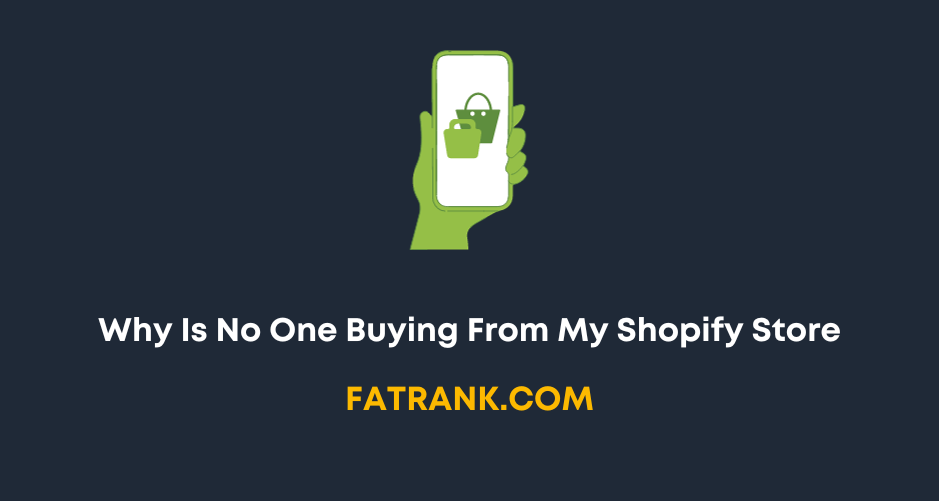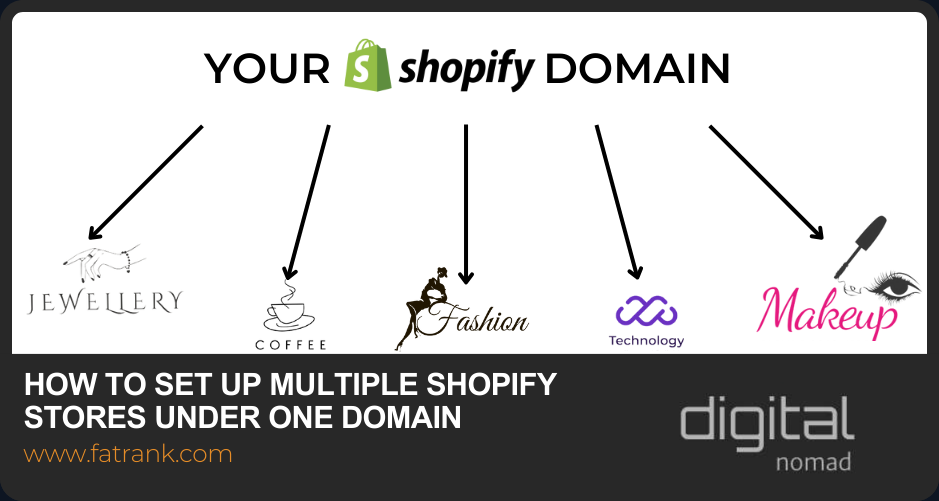
Why Is No One Buying From My Shopify Store
Are you struggling to drive sales on your Shopify store and wondering why customers aren’t making purchases? In this comprehensive guide, we’ll tackle the top 10 reasons why your Shopify store may fail to convert visitors into customers. From poor website design and user experience to limited product selection and high prices, we’ll address each potential issue and provide actionable solutions to help you improve your store’s sales performance.
We’ll delve into strategies for optimizing website design, building trust and credibility, investing in marketing and advertising, expanding your product selection, and offering competitive pricing and shipping options. Whether you’re a beginner or an experienced Shopify store owner, this article is packed with valuable insights to help you boost your sales and succeed in the competitive e-commerce landscape.
Contents
- Why Is No One Buying from My Shopify Store?
- Poor Website Design and User Experience
- Lack of Trust and Credibility
- Insufficient Marketing and Advertising
- Limited Product Selection
- High Prices and Shipping Costs
- Slow Loading Speed and Technical Issues
- Lack of Differentiation from Competitors
- Inadequate Customer Service and Support
- Poor Product Descriptions and Images
- Not Utilizing Social Media and Influencer Marketing
- How do you improve sales on your Shopify store?
- Frequently Asked Questions
- Why is no one buying from my Shopify store?
- How can I increase sales on my Shopify store?
- Is my product selection the reason for low sales on my Shopify store?
- Could my website design be turning potential customers away?
- Do I need to invest in marketing for my Shopify store?
- What should I do if my Shopify store still isn’t generating sales?
- Related To Why Is No One Buying From My Shopify Store Topics
Why Is No One Buying from My Shopify Store?
Are you wondering why your Shopify store is not attracting enough customers and generating sales despite your efforts?
Running a Shopify store comes with its challenges, especially when it comes to converting visitors into customers. Low conversion rates are a common issue that many store owners face. One of the reasons for this could be ineffective product descriptions. If your product descriptions are not compelling and informative, it can deter potential customers from making a purchase.
The impact of market research cannot be understated. Without a thorough understanding of your target customers, targeting and attracting them to your store effectively becomes difficult. Building website trust is crucial for increasing sales. Customers need to feel confident in the reliability and security of your site before they proceed to checkout.
Poor Website Design and User Experience
Your online store’s website design and user experience play a pivotal role in shaping potential customers’ first impressions and engagement.
Intuitive website design is essential for engaging visitors, capturing their attention, and ultimately converting them into customers. An intuitive and user-friendly interface helps users navigate seamlessly through your website. Mobile responsiveness is crucial in today’s digital landscape, as more users access websites via mobile devices. Efficient navigation and a clear layout enhance the overall accessibility of your website, making it easier for users to find what they are looking for.
Lack of Trust and Credibility
Establishing trust and credibility is essential for an online store to instill confidence in potential buyers and create a positive perception of the brand.
Transparency in business practices, such as clear return and refund policies, is crucial in building trust with customers. When individuals perceive a company as honest and reliable, they are more likely to make purchases and become repeat customers.
Featuring customer testimonials on the website can be a powerful tool in gaining the trust of new visitors. Hearing positive experiences from others can alleviate any hesitations about making a purchase.
Moreover, brand storytelling humanizes the brand and creates emotional connections with customers, fostering a sense of loyalty and trust.
Insufficient Marketing and Advertising
Effective marketing and advertising are crucial for promoting your online store and reaching your target audience through various channels, including social media and influencer partnerships.
Comprehensive marketing and advertising strategies are pivotal in building brand awareness, attracting potential customers, and driving sales. Leveraging social media promotion enables you to connect with diverse audiences, engage with your customer base, and foster a sense of community around your brand.
Collaborating with influencers who resonate with your target demographic can amplify your brand’s visibility and credibility. Their endorsement can help establish trust and authenticity, leading to stronger customer engagement and increased market outreach.
Limited Product Selection
The product selection of your online store plays a pivotal role in shaping its unique selling proposition and attracting a diverse range of customers with varied preferences.
By offering a wide array of products, ranging from fashion apparel and accessories to tech gadgets and eco-friendly home essentials, your store can cater to a broad spectrum of consumer needs.
Stocking limited edition items or exclusive collaborations with renowned designers can further elevate your store’s appeal, establishing it as a go-to destination for exclusive and in-demand products.
High Prices and Shipping Costs
Your online store’s pricing strategy and shipping costs significantly influence customers’ purchasing decisions and overall satisfaction with their shopping experience.
Customer perception regarding the pricing strategy can greatly affect the perceived value for money. Competitive pricing, discounts or promotions, and displaying the cost savings can attract potential buyers. Transparent and affordable shipping costs can minimize cart abandonment and drive higher conversion rates. Partnering with reliable payment processors and leveraging cost-effective shipping solutions can enhance the overall customer experience and build trust in your brand’s pricing and shipping policies.
Slow Loading Speed and Technical Issues
Your online store’s loading speed and technical performance significantly influence user experience and can impact customer retention and conversion rates.
Optimizing the loading speed and addressing technical issues are crucial elements that can shape the success of your website. A fast-loading site enhances user satisfaction and plays a pivotal role in securing higher search engine rankings. This, in turn, can increase natural traffic and improve overall visibility.
Technical optimization, including minification of CSS and JavaScript, utilizing browser caching, and optimizing images, can result in a smoother and quicker user experience. A well-optimized website can also positively influence user behavior, leading to higher engagement and better conversion rates.
Lack of Differentiation from Competitors
Setting your online store apart from competitors is essential for capturing the attention of potential customers and establishing a distinct brand identity.
Market research plays a crucial role in identifying these differentiators and understanding customer preferences and behaviors. By analyzing market trends, consumer needs, and the competitive landscape, businesses can develop a unique selling proposition (USP) that highlights their strengths and sets them apart. Leveraging competitive advantages allows companies to position themselves strategically and attract their target audience effectively. This differentiation strategy also helps build a loyal customer base and sustain long-term market success.
Inadequate Customer Service and Support
Providing exceptional customer service and support is crucial for fostering positive customer relationships and effectively addressing their inquiries or concerns.
One of the key strategies for enhancing customer interactions is to invest in comprehensive training for customer service representatives, ensuring that they possess the skills and knowledge necessary to engage with customers professionally and empathetically.
Leveraging advanced customer support technologies such as AI-powered chatbots and CRM systems can streamline the process of resolving customer issues promptly, leading to increased customer satisfaction.
By actively listening to customer feedback and implementing improvements based on their suggestions, businesses can demonstrate their commitment to providing exceptional customer support and fostering long-term loyalty among their customer base.
Poor Product Descriptions and Images
Compelling product descriptions and high-quality images are essential for conveying your products’ value and appeal while capturing potential customers’ interest.
Product descriptions are a powerful storytelling tool, enriching the customer’s understanding of product features and benefits. A well-crafted description informs and evokes emotions, driving an emotional connection with the audience. Similarly, imagery plays a vital role in enhancing the product’s aesthetic appeal and visual representation, providing customers with a glimpse of the actual experience they can expect. By combining compelling descriptions with visually captivating images, businesses can create an immersive shopping experience, ultimately influencing purchase decisions.
Not Utilizing Social Media and Influencer Marketing
Leveraging social media platforms and influencer marketing can significantly expand the reach and visibility of your online store, connecting with a wider audience and driving engagement.
By utilizing social media, businesses can instantly showcase their products or services to a global audience. The interactive nature of social platforms allows for direct communication with potential customers, fostering a sense of community and brand loyalty.
Partnering with influencers further amplifies this impact, as their authentic endorsements can sway the purchasing decisions of their followers. This strategy can help to position your brand in front of a highly targeted and engaged audience, ultimately driving conversions and sales.
How do you improve sales on your Shopify store?
Elevating sales performance on your Shopify store necessitates a comprehensive approach encompassing strategic enhancements in various facets of the business operation.
To improve conversion rates, conducting thorough market research is crucial to understand your target audience better. Utilizing data-driven insights can help optimize product offerings to meet your customers’ specific needs and preferences. Leveraging social media platforms to engage with potential buyers and promote your products is also essential. Implementing compelling content, visually appealing images, and targeted ad campaigns can increase customer engagement and sales.
Optimize Your Website Design and User Experience
Enhancing your online store’s website design and user experience is essential for creating an engaging and seamless interaction platform for potential customers.
One crucial aspect to consider when optimizing your website design is to ensure mobile responsiveness. With the increasing number of users accessing websites through mobile devices, it’s imperative to prioritize a seamless experience across various screen sizes. This can be achieved through responsive design techniques, such as utilizing flexible grid layouts and media queries to adapt the content.
Moreover, intuitive navigation plays a key role in enhancing user experience. Simplify the menu structure, implement clear call-to-action buttons, and minimize the number of clicks required to reach essential pages. This will improve user satisfaction and encourage exploration of your online store.
Build Trust and Credibility with Customers
Establishing trust and credibility with customers forms the bedrock of enduring relationships and positive brand perception, fostering loyalty and repeat business.
Transparency serves as the cornerstone of trust-building initiatives. By openly sharing information about products, services, and business practices, customers perceive transparency as a testament to your integrity and honesty.
Incorporating customer testimonials into your marketing communications provides first-hand validation of your brand’s value proposition. Sharing real-life experiences with satisfied customers offers a powerful means of demonstrating reliability and quality.
Personalized engagement further solidifies customer relationships by catering to individual needs and expectations, enhancing connection and understanding.
Invest in Marketing and Advertising Strategies
Strategic investments in marketing and advertising initiatives are integral for expanding the customer base and enhancing the visibility of your Shopify store across diverse channels.
Engaging with your potential audience through social media platforms like Instagram, Facebook, and Twitter can significantly elevate your brand’s presence and drive conversions. By leveraging user-generated content and fostering meaningful interactions, customer engagement can be enhanced, establishing a loyal community around your products or services.
Cultivating partnerships with relevant influencers in your niche can help amplify brand awareness and tap into new customer segments. Their authentic endorsements and reviews can build trust and credibility, leading to increased traffic and sales for your Shopify store.
Expand Your Product Selection
Diversifying and expanding the product selection of your online store presents opportunities for catering to a broader customer base and crafting a compelling, unique selling proposition.
One effective strategy for expanding the product offerings of a Shopify store involves conducting thorough market analysis to identify trends, gaps, and emerging opportunities. This analysis can help understand customer needs, preferences, and pain points, paving the way to introduce products that meet these diverse requirements. By creating a distinct product portfolio that addresses various customer segments, the store can differentiate itself in the market and establish a strong competitive advantage.
It’s essential to prioritize offering a range of products that align with the target market’s values, tastes, and usage habits, thus enhancing the appeal and relevance of the store’s offerings.
Offer Competitive Prices and Shipping Options
Competitive pricing and flexible shipping options can influence customer purchase decisions and foster satisfaction with the shopping experience.
Regarding pricing strategies, businesses should perform thorough market research to ensure their prices are competitive but still leave room for profitability. It’s crucial to strike a balance between meeting customer expectations and maximizing revenue.
Offering diverse shipping options such as expedited, standard, and free shipping can cater to varied customer needs and preferences.
Frequently Asked Questions
Why is no one buying from my Shopify store?
There could be several reasons why your Shopify store is not generating sales. It could be due to a lack of marketing efforts, poor website design, or unappealing product offerings.
How can I increase sales on my Shopify store?
You can implement various strategies to increase sales on your Shopify store. These include improving your website design, optimizing product descriptions, running targeted ad campaigns, and offering discounts or promotions.
Is my product selection the reason for low sales on my Shopify store?
Possibly. It’s important to regularly review your product offerings and make sure they align with your target audience’s interests and needs. Consider conducting market research and making necessary adjustments to your product selection.
Could my website design be turning potential customers away?
Yes, a poorly designed website can greatly impact your sales. Ensure your website is visually appealing, easy to navigate, and optimized for mobile devices.
Do I need to invest in marketing for my Shopify store?
Yes, marketing is crucial for driving traffic to your store and converting visitors into customers. Use social media, email marketing, and paid advertisements to reach your target audience.
What should I do if my Shopify store still isn’t generating sales?
If you’ve tried various strategies and your store is still not generating sales, it may be helpful to seek outside help. Consider hiring a Shopify expert or joining online communities to get advice and support from other successful store owners.
Related To Why Is No One Buying From My Shopify Store Topics
Here are all the topics related to Why Is No One Buying From My Shopify Store in July 2025.
- Can you change the Shopify URL Structure?

- How to Set up Multiple Shopify Stores Under One Domain

- Link Building for Shopify: Full Tutorial

- Why Is No One Buying From My Shopify Store


About FatRank
Our aim to explain and educate from a basic level to an advanced on SEO and Social Media Marketing.
- Triggering Google Suggests
- Online Reputation Management Quotes That Highlight Why Your Brand Perception Matters
- Trust-Based Revenue Share Lead Generation Model
- Online Reputation Management Agencies
- Best Online Reputation Management Consultants
- The Complete Local SEO Playbook 2025
- iGaming SEO: The Truth About Advanced SEO for Online Gambling
